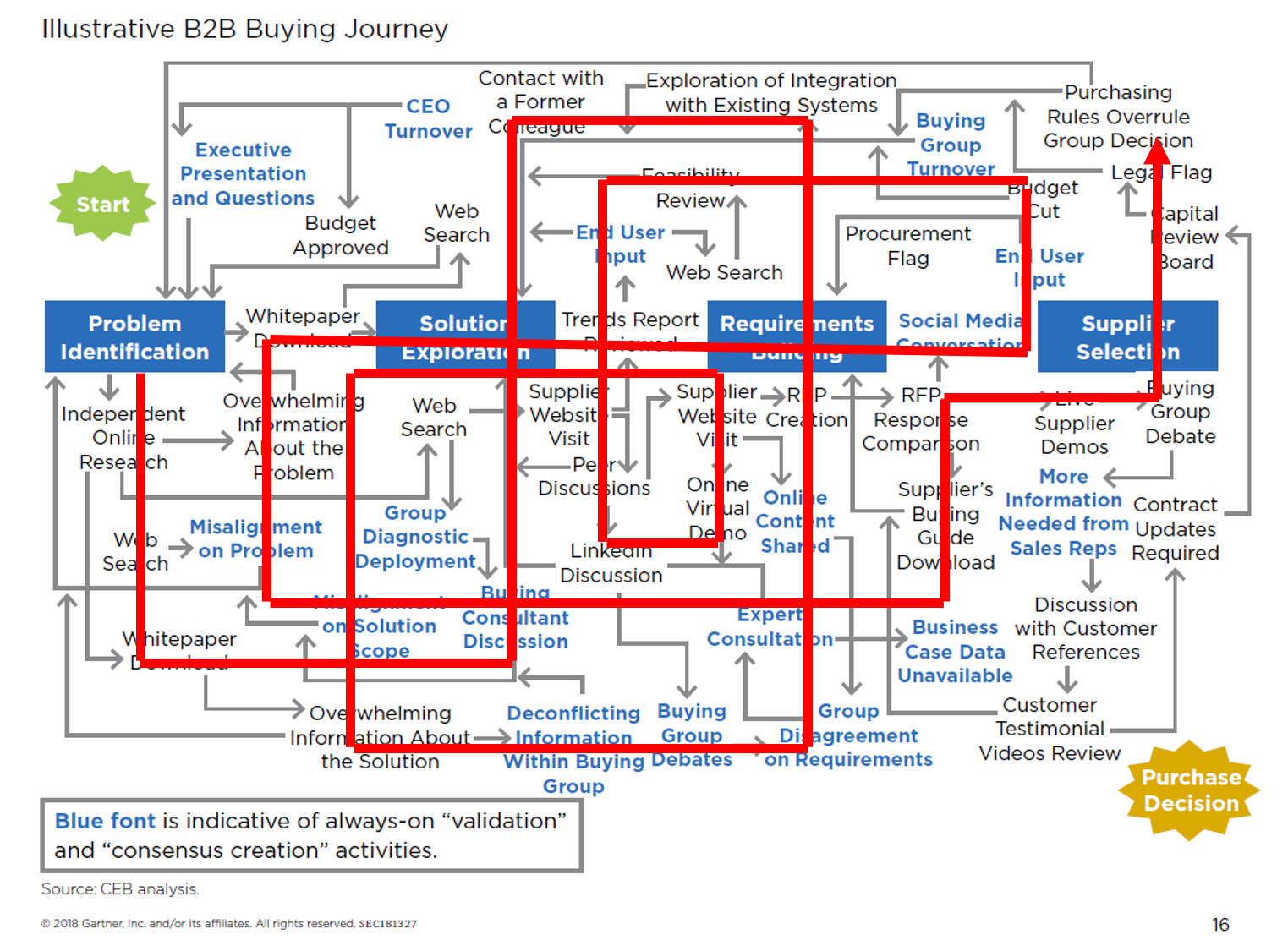Ever since I started selling–you know back in the old days when phones were still attached to cords–I’ve been taught, “Buyers have a structured buying process.”
I’d see all sorts of block diagrams, showing how the buying process always, coincidentally, aligned with the customer buying process. On the selling side we would have perfectly structured steps like Qualification, Needs Identification, Solution Presentation, Closing. These would, through some magic, always align with the customers’ very structured process, Problem Definition, Needs Definition, Evaluate Alternatives, Select/Buy A Solution.
The idea that sellers and buyers could be in perfect synchronization throughout the process, marching logically through it, culminating in a purchase decision has persisted for decades. The primary problem sellers had with this is they often skip steps, moving to solution presentation and closing, when the customer might have still been in the needs definition stage. The thinking being, as long as we stayed aligned with the customers’ process we could help them with their buying process, maximizing our ability to win.
My own company, years ago, did research with a client, examining about 400 purchase decisions, determining that for every stage of misalignment (eg. We were closing and the customer was still defining the problem), the probability of winning decreases by 15-20%.
We would co-mingle procurement processes with complex B2B buying processes, thinking they were the same thing. But when we think about it, they are really different. Procurement professionals go through “buying” every day. They have structured processes oriented to doing their jobs as effectively and efficiently as possible. With some exceptions, they are usually involved in transactional buying decisions. For example, buying parts/components to support making products, contracting for services, and so forth. With some exceptions, for complex B2B buying, they get involved later in the process, supporting the actual purchase.
For decades, many sellers pretended the only thing that mattered was marching effectively and efficiently through the selling process. These sellers tended to ignore or not care what the buyer was doing. They just focused on their jobs, Qualify, Demo, Propose, Close. Time and time again, sellers executed those steps, ignoring what the customer had to do to keep up.
And, as mentioned earlier, some of us recognized there is a buyer side to this, so we designed buying process models that always aligned with the things we wanted to do as sellers.
But then we started to see things changing—at least for complex B2B buying decisions. We saw how much customers struggled. They would start, stop, wander, change. They would often get lost. The famous Gartner “Spaghetti diagram” showed the reality of the customer buying journey.
We, also, have seen more and more people involved in the buying decision, in the past 12 years it has more than doubled. And we have learned that with more people involved, they struggled with gaining and maintaining consensus. As people go through this, we see it taking more time.
We’ve learned that customers get confused and overwhelmed. They don’t know what they are doing. Concepts like sensemaking and decision confidence became part of what great sellers did in helping customers navigate the process.
Then, through the Jolt Effect, we learn the majority of these buying journeys end in No Decision Made. The customers are plagued with uncertainty, doubt. And we discovered that FOMU was less about whether they were selecting the right solution, but more about whether they were doing the right thing–for their business and themselves.
Some are, slowly, recognizing that buyers really don’t know how to buy—at lease in complex B2B decisions. It makes sense, after all they don’t look at these changes every day. Some of these may be a “once in their career” decision. Some may be “every few years,” knowing things change profoundly in the intervening years.
These sellers recognize that sellers don’t know how to buy, so the assumption that a buying process with a series of logical blocks perfectly aligned with our selling process is wrong. They help the customer develop a project plan and a series of steps, helping them navigate the process. They help customers identify who should be involved, what they should be looking for, questions they should be asking. They help the customer develop the steps they should go through in making a decision and help the customer navigate that process.
But our focus on the “buying” aspect of the process, even if we help the customer navigate the process, still doesn’t recognize the reality of the customer situation.
The reality is the customer doesn’t wake up some morning with the brilliant idea, “We need to buy something!” Buying is, possibly, a small part of a much bigger initiative. It’s a change management initiative, a problem solving initiative, a growth or opportunity focused initiative.
The initiative started to address something within their company. They may not have even considered they might be purchasing something as part of the project. Buying might only arise as they look at alternative solutions to the issue they are addressing–so it comes very late in the process.
So our customers really aren’t on a buying journey, rather they are on a change/problem solving project.
And just like buying, our customers struggle with that process. After all, they don’t do these things every day (if they do, the organization has much deeper issues). They don’t know how to manage that process. We have data through research by people like Morten Hansen, about how people struggle with these projects, and how the majority of them fail.
Yet we are still focused on our perfectly aligned blocks of the selling/buying process, wondering why they aren’t working as effectively as they used to. We fail to recognize these perfectly aligned and executed steps do not reflect the reality of what our customers are doing. We also fail to recognize that our focus on buying is the smallest part of the what the customer is facing.
We also fail to recognize how much experience and expertise that we can bring our customers to support their change management/problem solving process. After all, our customers have gone through similar experiences before. Ideally, we have learned through the collective experiences of customers facing similar situations.
Also, hopefully we have realized that we can’t wait to engage the customer only in the buying stage of their project–that often that’s way to late to influence their thinking, but far more often, they don’t reach that point because they get lost and give up. And we see the top performing sellers shifting their engagement strategies to help the customer with their problem. These sellers help their customers navigate the problem solving process, helping them reach and navigate the buying decision.
And those sellers create stunning results—with their customers and for their own organizations. More customers successfully navigate this problem solving journey. These sellers become much more trusted, in fact they become a partner/resource to the customer in navigating that process. And through this win rates skyrocket.
Because these sellers help the customer navigate the change process, fewer change management projects fail. They face fewer “No Decision Made.”
And, perhaps counterintuitively, the entire “journey” can be much shorter (we’ve seen 30-40%). The reason is that these sellers help the customer navigate their process much more effectively. They help reduce the wandering, the starts and stops, the shifts in direction and priority. As a result, the customer gets to their desired outcome much more quickly and effectively.
Most of the time, we focus on our “selling journey.” Sometimes, we bridge that to help the customer with their buying journey.
But the reality is, the customer is on a completely different journey. And we create much greater value, with them, by focusing on the journey they are on.


Closing early, Closing Often.
“the probability of winning decreases by 15-20%.”
In research across thousands of sales calls:
was 40% drop at first early close,
60% at second,
and a fatal 100% loss at third.
This when “you have to close FIVE times” was a mantra in selling.
I use this as “closing for an interim commitment” or closing for the sale.
Few Buyers set out on a journey to “buy” a product or service, except Supermarket “produce” Buyers.
For most of us the desire, need or want by Customers for our Product or Service
occurred during the Customer’s Journey to Business survival or success.
The evidence says its more than “Problem Solving”, or Solutions searching, but its “Opportunity taking”, too.
Sellers, their managers, and Senior Directors would do well to reach for. and read their copy. of Igor Ansoff’s “Corporate Strategy.”
It’s not a Novel, it’s so much more than a Product Market Matrix, it’s a treatise on BUSINESS.
Inside the Corporate Journey, which defines the Buyer’s Buying Journey is laid bare.
Where are we now?
where are we going, and why there?
how will we get there?
what do we need?
who can help us?
This also fully defines the Sellers Journey, as without a Buyer, there is NO JOURNEY.
Great Topic, Dave
I always love your comments Brian, you have such a unique way of helping us get to the core issues. Thanks so much!